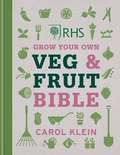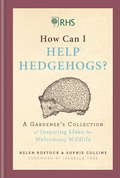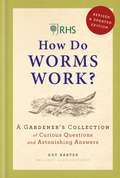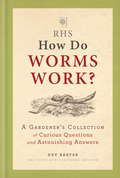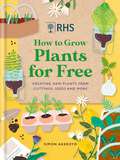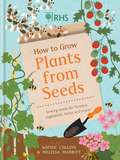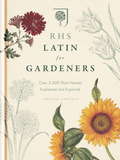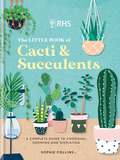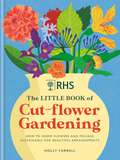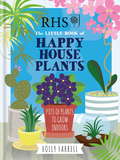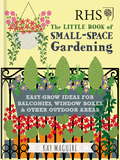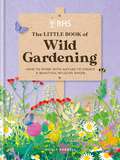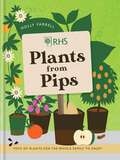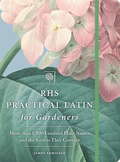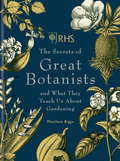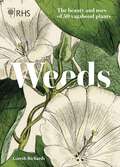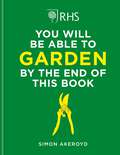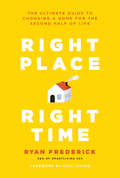- Table View
- List View
RHS Grow Your Own Veg & Fruit Bible
by Carol KleinHighly-regarded gardener Carol Klein has collaborated with the Royal Horticultural Society to create a lavishly illustrated, easy-to-follow, practical and inspiring beginner's guide to everything you need to know to grow fruit, vegetables, salads and herbs all year round.With an approach that is environmentally friendly and easy, Carol gives all the advice you need to succeed. Beginners and experienced gardeners alike will be inspired by this indispensable reference for every gardener's bookshelf.Whatever the size of the garden, this is a book to convert readers to the pleasures of growing and harvesting their own food. From preparing a plot, planning what to plant, and how to grow any one of the 80 featured food plants, this is a book to which growers can return every year, whatever their level of expertise. Key techniques are shown in step-by-step photography and there are invaluable illustrated directories of the best varieties to select for best results.With her usual energy and enthusiasm, Carol Klein offers green-fingered advice for growing all your appetizing favourites plus many less familiar crops also.The material is taken from the bestselling RHS Grow Your Own: Veg and RHS Grow Your Own: Fruit.
RHS Grow Your Own Veg Through the Year: 365 Days of Homegrown Vegetables & Herbs
by Royal Horticultural SocietyPlan smart, grow sustainably, and eat healthily with home-grown crops for every day of the year.In Grow Your Own Veg Through the Year experts from the world-renowned Royal Horticultural Society reveal the best vegetables and herbs to grow today, with practical advice to produce healthy harvests from any size of plot. From the widest range of tomatoes and potatoes to the more eclectic edibles such as oca and ginger, this book shows you how to: * Choose vegetables, herbs, edible flowers and exoticcrops for the best home-grown taste* Pick plants for every situation: sun, shade, dry soil,damp soil, pots, raised beds, vertical veg and windowsills* Make plans for a rainbow harvest and great gut health* Grow crops using RHS sustainable practice to supporteco-systems, and protect wildlife and the planet* Plan your year to save time and energy and to maximize whatyou can grow* Feel confident with 120+ crops, grouped into families,with problem-solving tips and best varieties
RHS Horti Curious: A Gardener's Miscellany of Fascinating Facts & Remarkable Plants
by Ann Treneman'A brilliant book that in one easy read has turned me into an 'expert' on just about every aspect of plants and gardening' Joe SwiftWhat is xeriscaping? How do you make a seed bomb? Why should you avoid the gympie-gympie tree? When was the first botanical garden created? What type of tulip was once as expensive as a house?Delve into the lush world of Horti Curious, where you will find the answers to of all of these questions, along with hundreds of other entertaining and enlightening facts. Written by gardener and columnist for The Times, Ann Treneman, with the expert advice of the RHS, every page is a verdant oasis brimming with knowledge and inspiration for gardeners and plant lovers.From forgotten folklore to famous gardeners, and from incredible edibles to poisonous plants, this compendium of curiosities celebrates the diverse wonders of horticulture and botany.Beautifully illustrated with botanical diagrams and graphics, this miscellany will inform and delight gardeners and plant lovers. A 'pick and mix' of horticultural knowledge, it ranges from local to global, filled with maps, historical biographies, scientific explorations, plant profiles, fun and unbelievable facts, recipes and tips.
RHS How Can I Help Hedgehogs?: A Gardener’s Collection of Inspiring Ideas for Welcoming Wildlife
by Sophie Collins Helen BostockForeword written by Isabella Tree of the Knepp Wildland Project.RHS How Can I Help Hedgehogs? offers more than 100 ideas for you to help wildlife thrive in your garden. Packed with simple, low-cost ideas that will make a huge difference to the natural world, the book suggests ways to help birds, bees, butterflies, beetles and many other declining species.Hopeful, informative and entertaining, with plenty of 'I-never-knew-that' mini-features, this is a book you and your family need, and one that you'll all enjoy, too. Includes topics such as how to increase the biodiversity of your plot and how to improve your soil without using chemicals.Includes...- Can I make my garden bat-friendly?- Do green roofs work?- Why should I love my weeds?- Should I keep honey bees?- Which flowers are friendliest for moths?- Where's best for a bird box?- Is garden lighting disruptive?...and many more.
RHS How Do Worms Work?: A Gardener's Collection of Curious Questions and Astonishing Answers
by Guy Barter The Royal Horticultural Society'This is a lovely book to dip into, and you may even find yourself reading it cover to cover' - the Guardian'An enlightening and entertaining read that will leave the reader armed with the facts and insight to improve their garden as well as their general knowledge' - The English GardenRHS How Do Worms Work? provides expert answers to the questions that every gardener wants to ask - and a few that you never even dreamt of. As well as answering the titular question about soil's best friend, this fact-filled journey through the world of the garden is packed with Q&As that are sometimes practical, sometimes whimsical and always intriguing. This richly illustrated volume is an absorbing guide to the quirky and lesser-known aspects of gardening and a perfect gift for any gardener with an inquisitive mind.With sections on Seeds and Plants; Flowers and Fruits; Below the Ground; Weather, Climate and the Seasons; and In the Garden, RHS How Do Worms Work? holds the answers to common questions such as:- What's the difference between a fruit and a vegetable?- Is it true that sunflower heads follow the sun?- When is a plant a weed?- How do you attract butterflies?- How long can a plant survive without water?and many more.
RHS How Do Worms Work?: A Gardener's Collection of Curious Questions and Astonishing Answers
by The Royal Horticultural Society Guy BarterEver wondered how worms breathe? Or why exactly trees are so big? This book covers all aspects of gardens and gardening, and will satisfy all your horticultural curiosity. Packed with photographs, vintage engravings and diagrams, this book will answer everything from the practical to the quirky and whimsical. Feature boxes provide practical guidance, so that you can apply your new-found knowledge to your own garden. Written by the head of the RHS Members' Advisory Service, this book is the ideal gift for fact-loving gardeners with curious minds.
RHS How to Grow Plants for Free: Creating New Plants from Cuttings, Seeds and More
by Simon AkeroydIncrease your stock of plants easily and for free by propagating them yourself. RHS How to Grow Plants for Free demystifies the art of taking cuttings and explains the other ways you can multiply your garden plants. Propagating your own plants is fun, inexpensive, and a sustainable way to garden.An introductory section explains the botanical science behind all types of propagation and defines and simplifies the language. The book is then split into self-contained practical chapters detailing each of the different types of propagation. Each chapter includes a selection of 'plant profiles' for the plants best suited to eachpropagation method: - Dividing Plants covers the easiest methods of splitting one plant into several new ones- Saving Seeds introduces how to collect and process seeds from flowers, vegetables, herbs and trees- Cuttings covers how to successfully grow a new plant from an existing one using several different methods for taking cuttings- The Houseplants chapter shows techniques needed to increase your collection.- The final chapters show how to grow new plants from kitchen scraps, and gives ideas on how to make the most of all the new plants you've created by giving them as gifts
RHS How to Grow Plants from Seeds: Sowing seeds for flowers, vegetables, herbs and more
by Sophie CollinsHow To Grow Plants From Seeds does away, once and for all, with the idea that there's something difficult about growing direct from seed. There's no need to rely on the professionals to raise seedlings for you: seeds are not only cheap to buy and environmentally friendly but, if you follow a few basic rules, they're also fantastically rewarding, not least because a single packet will usually leave you with plenty of spares to swap with fellow enthusiasts.Whether you're a novice or an experienced gardener, if you want to nurture an impressive cutting garden or aim to have a bounteous harvest of fruit and vegetables, here's what you need to know, presented in a straightforward and accessible way. You'll discover the basic rules for different seeds, their sowing preferences (Indoor, under cover or direct- to-plot? Surface-sow or cover up? Water or spray?), how long they take to germinate, and how to prick out, pot on and raise your infant plants to become sturdy, productive adults.The book opens with a basic primer showing how seeds work, to give every grower the best chance at success. This is followed by extensive chapters on raising food and flowers from seed with plenty of detailed plant profiles included, and finally there's a guide to collecting seeds from your plants and how to save and swap - so that you, too, can become a seed evangelist.
RHS Latin for Gardeners: Over 3,000 Plant Names Explained and Explored
by The Royal Horticultural SocietyAided by this book the gardener can now answer the question "What's in a name?" and they and their garden will benefit from understanding the wealth of information that has hitherto lain hidden within the mysterious world of Latin names.' - Financial Times OnlineRHS Latin for Gardeners is an informative, entertaining and beautifully illustrated unravelling of the mysteries of botanical Latin. Over 3,000 Latin names are listed alphabetically, showing how plant names can reveal where a plant originally comes from (and thus its preferred growing conditions), along with such properties as its shape, form, colour, taste, and smell. Each name is clearly defined and accompanied by a pronunciation guide, and the pages are filled with attractive botanical illustrations. Fascinating feature spreads retell the adventures of important plant hunters such as Sir Joseph Banks and Alexander von Humboldt, and explain how their discoveries affect the way our gardens look today. Individual plants are also profiled throughout, showing how their names can illuminate their hidden histories. Aided by this book, every gardener, and their garden, will benefit from uncovering the wealth of information that lies within the remarkable world of Latin binomials. A little Latin can do a lot of good - apply the lore of Latin to your own garden!Contents includes...The A-Z Listings of Latin Plant NamesPlant ProfilesPlant HuntersPlant Themes...And Much More!
RHS The Little Book of Cacti & Succulents: The complete guide to choosing, growing and displaying
by Sophie CollinsWith fans far and wide, cacti and succulents come in myriad shapes and sizes too. These firm favourites of Instagram influencers are perfect for adding greenery indoors, and can add structure and detail to outdoor spaces as well. Smaller plants are companions for 'generation rent', since they are easily moved from place to place. Generally low-maintenance, being 'plant mum' to one or two of these tiny plants often starts a life-long fascination, and an ever growing horde.The Little Book of Cacti and Succulents is an inspiring and indispensable guide to growing these fascinating plants. Detailed Plant Profiles are divided into sections according to style and shape, from beautiful trailing plants to intricately formed rosettes. At the beginning of the book, you'll find practical advice on getting started, caring for the plants through the year and how best to show your plants off. You can also discover how to grow your collection using various propagation techniques with step-by-step guidance.Cacti and succulents provide year-round interest for very little input, and caring for their fascinating forms is an enchanting hobby. Full of beautiful photography and sweet illustrations, The Little Book of Cacti and Succulents is an encouraging and down-to-earth guide to these weird and wonderful plants.
RHS The Little Book of Cut-Flower Gardening: How to grow flowers and foliage sustainably for beautiful arrangements
by Holly FarrellFlowers brighten our homes, our lives and, when they are homegrown, they also brighten our gardens - not just for us, but also for the buzzing wildlife that loves their nectar. Growing your own flowers gives the huge satisfaction of harvesting something from a plant you have nurtured, and brings a greater connection with nature and the seasons. It also allows you to have a house full of flowers at a fraction of the cost of buying them, all with a sustainable, positive environmental impact. RHS The Little Book of Cut-Flower Gardening is the perfect introduction to growing your own blooms. Whether your cut-flower patch is a handful of pots or half an allotment, you'll find accessible information on successful and sustainable growing, to keep your plot healthy and as productive as possible. As well as introductory chapters on planning and gardening basics, there are details on how to cut your flowers and extend their vase life,and how to dry flowers for everlasting arrangements.More than just flowers, the directories break down the blooms and foliage into their different groups. There are sections on annuals from seed, such as love-in-a-mist, ammi and sweet peas; growing bulbs and tubers such as tulips and dahlias; perennials for flower and foliage, such as lady's mantle, lavender, roses, apple mint and ornamental grasses; and shrubs and trees for foliage, flower, spring blossom and colourful winter stems.
RHS Little Book of Happy Houseplants
by Holly FarrellGrowing indoors has never been easier or more fun. Become a star gardener without leaving your home with this beginner's guide to houseplants for the whole family.Whatever the size of your home, and even if you don't have much spare time on your hands, house plants are an exciting way to bring some low-maintenance greenery into your life. As well as looking luscious, house plants improve air quality and our sense of well-being - and caring for them is an endlessly enchanting hobby for both adults and children. See how a knobbly ginger root sprouts huge exotic leaves, or how plants can grow without any soil at all. Children can get up close and personal with the natural world and try their hand at growing with ease. Best of all, the plants provide year-round interest and there's never any need to go out into the rain. In RHS Little Book of Happy House Plants, every technique and project is explained and illustrated in clear, down-to-earth steps. Even beginners will want to have a go!
RHS Little Book of Small-Space Gardening: Easy-grow Ideas for Balconies, Window Boxes & Other Outdoor Areas
by Kay MaguireMake the most of your balconies and windowsills with this handy gardening guide from the author of the award-winning RHS Grow Your Own Crops in Pots.RHS Little Book of Small-space Gardening is packed with practical information and inspirational ideas for anyone who wants to grow plants in a variety of outside spaces, from balconies to stairways, windowsills to doorsteps. Look inside to discover a host of creative step-by-step projects, such as speedy salads, wildlife pots, fragrant baskets and green garden walls. Handy plant profiles tell you what's best to grow in a variety of conditions, such as wind, shade and drought.Whether you choose to start with a simple pot or tackle a more ambitious project, with this beautifully illustrated book you'll soon see how even the smallest spaces can be amazing growing spaces.
RHS The Little Book of Wild Gardening: How to work with nature to create a beautiful wildlife haven
by Holly FarrellThe Little Book of Wild Gardening is a guide for anyone wanting to garden in a more sustainable, natural way. Working with nature benefits not just the garden, but also the gardener, wildlife and the wider environment. Divided into sections for different garden areas - including lawns, flower beds, edibles, trees and water features - The Little Book of Wild Gardening details how to embrace a natural approach to gardening for plots large and small.Introductory chapters explain how garden ecosystems can work, and how a healthy garden can mean savings in both work and resources for the gardener. There are plant profiles providing a variety of choices for a wilder approach, plus design tips and expertise in sustainable and wildlife-friendly gardening. From a sustainable veg patch to wildflower meadows, and from bat boxes to gravel gardens, the book includes projects and plants in a range of sizes and timescales so gardeners can create a bountiful and enjoyable haven that will benefit themselves, their local area, and all kinds of wildlife.
RHS Plants from Pips: Pots of plants for the whole family to enjoy
by Holly FarrellNEW EDITION COMING AUGUST 2021What do avocados, apples, mangos and tomatoes have in common? The answer is that they can all be grown at home, for free, from pips that you would otherwise throw into the recycling bin.RHS Plants from Pips shows you how to grow a range of fruit and vegetables, indoors and out, with minimum equipment and experience. This complete guide covers everything from the science of how plants grow to how to deal with pests and other problems. Find out what to grow, what to grow it in and when and where to grow it for the best results. Packed with colourful photographs and step-by-step illustrations, this is the perfect way to introduce beginners of all ages, from 6 to 60, to the joys of watching things grow.
RHS Practical Latin for Gardeners: More than 1,500 Essential Plant Names and the Secrets They Contain
by The Royal Horticultural SocietyRHS Practical Latin for Gardeners is a unique guide to plant binomials based on the bestselling RHS Latin for Gardeners. It contains 1,500 of the most useful and most widespread Latin names, organized into thematic chapters including Colour, Size, Form and Habitat. Each chapter is further subdivided into smaller groups, such as large plants and small plants. This allows gardeners to make new connections and discoveries in a way standard alphabetical lists don't permit. 'Behind the Name' feature boxes further increase the book's practical value, and a wide range of botanical watercolours ensure that it is beautiful as well as functional. This book includes a definition and pronunciation guide for each word, as well as a 16-page alphabetical index, so that it can still be used as a conventional dictionary of Latin names. And its handy, pocket-sized format makes it the perfect gift.
RHS The Secrets of Great Botanists: and What They Teach Us About Gardening
by Matthew BiggsBotanists are the trailblazers who first discovered how plants work and collected from around the world many of the species that we find in our gardens today. This informative and beautiful guide presents the stories of 35 plant collectors and gardening pioneers of the past and present, including Joseph Banks, Asa Gray and Marianne North.Arranged in chronological order, each profile covers one botanist, presenting their life story, discoveries and legacy, while special feature pages reveal their secrets, exploring the qualities that brought them success and showing what ordinary gardeners can learn from them.Illustrated with beautiful period botanical watercolours and vibrant photographs, RHS The Secrets of Great Botanists will provide inspiration and practical guidance for gardeners of all levels, from successful plant cultivation to adding interest to your garden.
RHS Small Garden Handbook: Making the most of your outdoor space (Royal Horticultural Society Handbooks)
by Andrew Wilson'RHS Small Garden Handbook...show[s] the process of planning, planting and maintaining an outdoor space that will lift your heart every time you step outside.' - The Independent 'Clear and practical principles of design' - BBC Gardens IllustratedA garden offers invaluable space for relaxing entertaining, and, above all, enjoying the huge pleasure of growing your own flowers, shrubs, trees, and crops. However, a small garden can present challenges to even the most experience gardener: it may be overlooked, which can impact upon your privacy; there may be more shade than you would like; and it may not be immediately obvious how to create a space that is both multifunctional and beautiful. RHS Small Garden Handbook provides an all-in-one guide for small space gardeners and draws on the experience in growing, planting, landscaping and design for which the RHS is world famous. It begins by explaining how to assess your plot so that you are aware of the soil, orientation, microclimate, existing materials and proportions that you have to work with, before revealing the principles of good design. Showing how your decisions on layout, colour and texture will affect the finished design and what tricks can be played to create a greater sense of space - with everything from expert design advice on boundaries, hedges and fences to clever ideas for containers and storage - every gardener will gain confidence in creating a garden to enjoy no matter how big the plot. Each of the nine chapters includes 15 ways to make instant improvements and a real-life case study to inspire change. All the gardens featured in the book's 300 photographs are accessible, achievable and truly inspirational.Contents Includes...BasicsDesign StylesMaterialsBoundariesStructuresWater PlantingUpkeep... and much much more!
RHS The Urban Gardener
by Matt JamesGarden designer, lecturer and broadcaster Matt James explores how to design an urban outdoor space, no matter the size or location - from balconies and roof terraces to courtyards, basement areas and front gardens, factoring in areas for relaxation, play and growing your own produce.There are 16 step-by-step projects including creating a 'living' green wall, planting under mature trees and making a gravel garden and 13 case studies showing great design in action, with examples from Tom Stuart-Smith, Charlotte Rowe and Christopher Bradley-Hole. Award-winning photographer Marianne Majerus provides the visual inspiration.
RHS Weeds: the beauty and uses of 50 vagabond plants
by Gareth Richards Royal Horticultural SocietyThe Times Top 10 Gardening Books 2021 Gardens Illustrated Books of the Year 2021 RHS Weeds gathers together 50 untamed and beautifully wild plant species, illustrated with exquisite botanical images. These subversive species no longer need to be seen as 'plants out of place'. In the modern garden, where harmony with nature and the ability to thrive under challenging conditions are key, weeds are finally getting their moment in the sun. RHS Weeds highlights the delicate charms of some of the most fascinating vagabond plants around. Beautiful botanical illustrations, including many from the Royal Horticultural Society's collections, and captivating profiles by RHS author Gareth Richards, provide key information for the modern gardener on the characteristics, usefulness and cultivation of these unsung heroes of the plant world.
RHS You Will Be Able to Garden By the End of This Book
by Simon AkeroydThe title might sound like a bold statement, but you really will be able to garden by the end of this book. Whether you are a budding botanist or just aspire to have greener fingers, this book will hold your 'horticultural hand' and guide you gently through the principles of gardening. Whether you have a tiny courtyard or something a bit bigger, this book will share everything you need to know to create your own patch of horticultural heaven. With 12 easy-to-follow chapters that explore all the basics of successful, stress-free gardening including assessing and designing your garden, how to grow fruit and vegetables, plant maintenance, propagation, lawns and container garden. The 15 step-by-step techniques will teach you how to sow seeds, prune shrubs, cut a hedge, mow a lawn and even how to design your own outside space, plus so much more. Just as important, the book explains how to garden sustainably and encourage wildlife, so that you can make informed decisions when it comes to creating and maintaining your garden.
Rhs Your Wellbeing Garden: How To Make Your Garden Good For You
by Royal Horticultural SocietyDiscover... How certain plants can form a barrier against air and noise pollution Which birdsong alleviates anxiety How plants can help to save energy Why green is so good for us Learn how connecting with nature can reduce stress and improve wellbeing. You don't even need a garden - even a balcony or houseplants can help to boost your mood. Every recommendation is backed by scientific research, drawn together by the team of RHS scientists and experts. Favourite garden designer at the RHS Chelsea Flower Show Matt Keightley then suggests how to translate the science into ideas for your green space. With this groundbreaking book, find out how, in sometimes very simple ways, you can create an outdoor space that nourishes your mind and body, and is good for our planet too.
Right Place, Right Time: The Ultimate Guide to Choosing a Home for the Second Half of Life
by Ryan FrederickWondering where to live in your later years? This strategic and thoughtful guide is aimed at anyone looking to determine the best place to call home during the second half of life.Place plays a significant but often unacknowledged role in health and happiness. The right place elevates personal well-being. It can help promote purpose, facilitate human connection, catalyze physical activity, support financial health, and inspire community engagement. Conversely, the wrong place can be detrimental to health, as the COVID-19 pandemic has highlighted. In Right Place, Right Time, Ryan Frederick argues that where you live matters enormously—especially during the second half of your life. Frederick, the CEO of SmartLiving 360 and a recognized thought leader on the intersection of place and healthy aging, provides you with tools to evaluate your living situation, ensuring that you weigh all the necessary factors to make a sound decision that optimizes your current and future well-being. He explores the pros and cons of different living options, from remaining in your current home to downsizing, intergenerational living, co-housing, senior living, and more. Along the way, he helps readers answer important questions, including "Are you already in the right place?" and "In what areas does your current place not align with your needs and desires?" The rest of the book helps you to unpack specific options for place, beginning with considerations for regions and neighborhoods and then looking at specific housing models. It also focuses on how housing is changing, particularly from a technology, health, and health care perspective. The book closes by challenging the reader to develop a discipline of choosing the right place at the right time.Combining real-life stories about people selecting places to live with design thinking principles and interactive tools, Right Place, Right Time will appeal to empty nesters, retirees, solo agers, and even adult children seeking ways to support their parents and loved ones.
Right Place, Right Time: The Ultimate Guide to Choosing a Home for the Second Half of Life
by Ryan FrederickWondering where to live in your later years? This strategic and thoughtful guide is aimed at anyone looking to determine the best place to call home during the second half of life.Place plays a significant but often unacknowledged role in health and happiness. The right place elevates personal well-being. It can help promote purpose, facilitate human connection, catalyze physical activity, support financial health, and inspire community engagement. Conversely, the wrong place can be detrimental to health, as the COVID-19 pandemic has highlighted. In Right Place, Right Time, Ryan Frederick argues that where you live matters enormously—especially during the second half of your life. Frederick, the CEO of SmartLiving 360 and a recognized thought leader on the intersection of place and healthy aging, provides you with tools to evaluate your living situation, ensuring that you weigh all the necessary factors to make a sound decision that optimizes your current and future well-being. He explores the pros and cons of different living options, from remaining in your current home to downsizing, intergenerational living, co-housing, senior living, and more. Along the way, he helps readers answer important questions, including "Are you already in the right place?" and "In what areas does your current place not align with your needs and desires?" The rest of the book helps you to unpack specific options for place, beginning with considerations for regions and neighborhoods and then looking at specific housing models. It also focuses on how housing is changing, particularly from a technology, health, and health care perspective. The book closes by challenging the reader to develop a discipline of choosing the right place at the right time.Combining real-life stories about people selecting places to live with design thinking principles and interactive tools, Right Place, Right Time will appeal to empty nesters, retirees, solo agers, and even adult children seeking ways to support their parents and loved ones.
Right Rose, Right Place
by Peter SchneiderPeter Schneider challenges the notorious myth that roses are difficult to grow, arguing that it&’s all about choosing the right petals for the right place! Providing in-depth profiles of hundreds of varieties, Schneider helps you decide which roses will work best in your flower bed or along an eye-catching garden trellis. Simple instructions that use proven techniques make growing roses easy and enjoyable, even in colder climates, while more than 400 gorgeous photos make this book as visually irresistible as it is useful.
